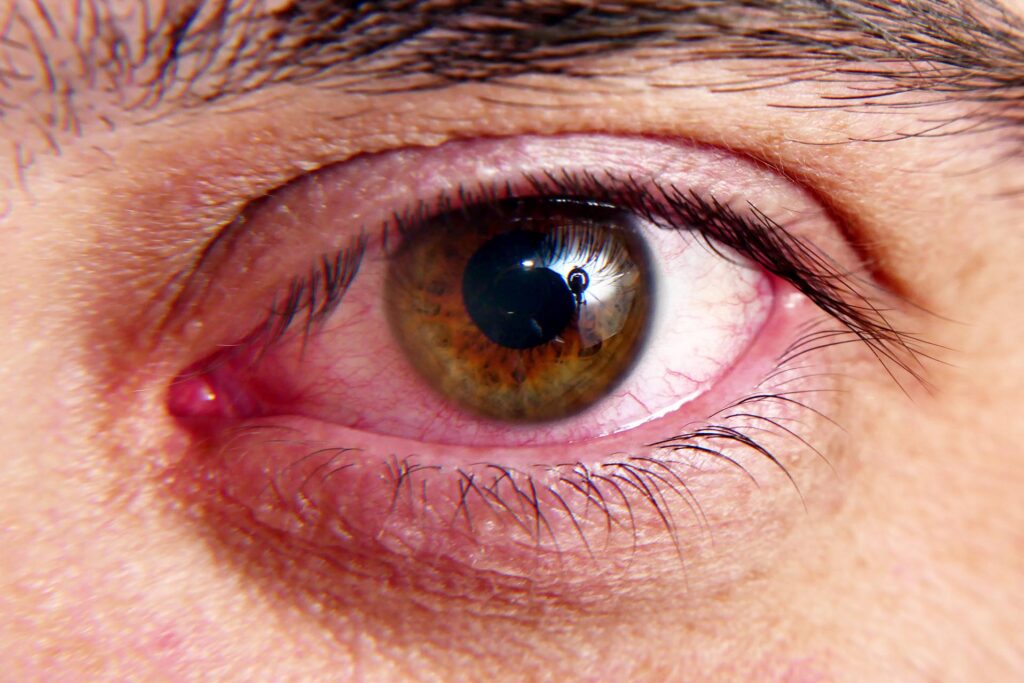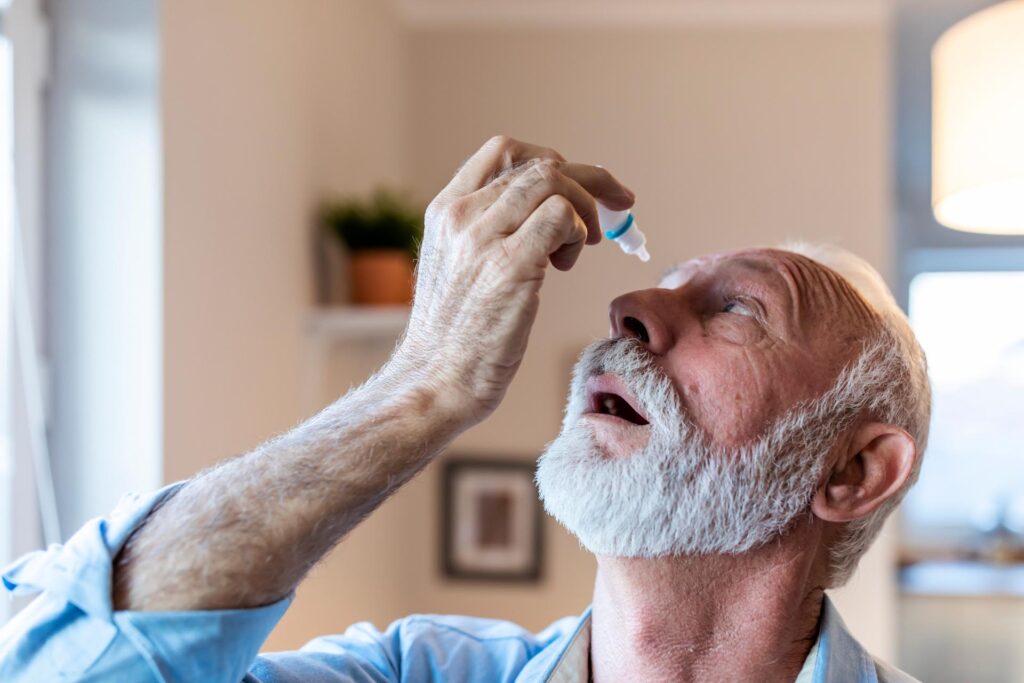Dry eye
What is a dry eye?
The tear fluid keeps the eye moist. This tear fluid is a film consisting of 3 layers. The lower layer lies directly on the eye and contains mucus. It is produced by secretions from small glands in the conjunctiva. Due to this layer, the middle of the three layers sticks and spreads better on the eye. This middle layer is watery and is generated by the tear ducts. The tear glands are located below the outer arch of the eyebrow above the eye and conjunctiva. The conjunctiva is a protective membrane that covers the inside of the eyelid and the outside of the sclera. This watery middle layer has a purifying effect. The upper layer of tear fluid is produced by the Meibomian glands, which are located on the edge of the eyelid. This layer is oily and ensures that the tear fluid does not evaporate as much.
When there is a disruption in this complex system and the production and distribution of tears on the surface of the eye is no longer given, we speak of dry eyes. A dry eye can water, burn, be red, itchy and tired without cause. If the eye is not moist enough, it feels like there is a foreign body in it. It waters excessively and hurts. Two types of tears are secreted by the lacrimal glands. With the constant tears, the eye is meant to be kept constantly moist. This contains proteins, fats and also antibodies. With strong emotions and irritations as well as injuries of the eye, other tears are secreted reflexively. The regular blinking of the eyelids, the film of the tear fluid and the reflex tears ensure that the eye is kept moist and comfortable and the eye is protected.
What causes dry eyes?
There are various reasons that can lead to dry eyes. Blinking ensures that the eye is moistened and thus kept moist. The tears are spread over the surface of the eye and directed toward the nose, where they drain. Dry eyes result when tears drain too quickly. Age also plays a role; tear production can decrease by up to 60%. Too dry air or wind can also make the eyes dry. Contact lenses, especially soft ones, can promote tear evaporation and cause irritation. There is a wide range of medications that can also lead to decreased tear production.
What treatment options are there?
Various treatment options are available. Artificial tears can be put in the eye regularly, this is the simplest method. However, this does not remedy the reduced tear secretion. It is a method that must be used constantly.
Since the cause of dry eyes can be very diverse, there is no universal treatment. Since the ‘dry eye’ is a chronic disease, it cannot be eliminated permanently without restrictions. The cause must be found in order to find the solution. This requires a lot of patience from the doctor and the patient. The ophthalmologist has experience with other patients who have had dry eyes. However, it requires individual cooperation between doctor and patient in order to find the best possible way. Only patient trial and error can lead to long-term success.
Keep your eyes moisturized
Artificial tears, i.e. wetting agents or tear substitutes, are the basis for relieving dry eyes. This forms a protective and lubricating film on the surface of the eye and stabilizes any tear film that is still present. They come in a wide variety of compositions.
The following applies to artificial tears:
The thicker it is, the longer it lasts. A viscous tear substitute adheres better and the surface of the eye stays moist longer, but vision is also blurred for some time.
There is such a large variety of preparations that the tolerability and effectiveness of the various agents are perceived very differently. The preparation that is most tolerable and effective for the individual patient must be found.
When choosing artificial tears, preference should be given to those without preservatives, especially if they are used frequently or in the case of allergy sufferers.
Tear substitutes without preservatives should also be chosen for wearers of soft contact lenses. Additives can accumulate in the contact lens. This can damage the cornea. The use of contact lenses for ‘dry eyes’ should be discussed individually with the ophthalmologist.
When it comes to artificial tears, there is no such thing as too much – just too little. The remedy should be used regularly, before symptoms appear.
If symptoms arise from wetting agents, these can usually be remedied, otherwise other treatment options are available.
Care of the lid edges and lids
If there is inflammation of the lid edges, lid edge care is important. This treatment is designed to remove sloughing and crusting from the edges of the eyelids. This is intended to increase the outflow of the oily phase of the tear film from the Meibomian glands. Lid edge care can be supported by massaging in a suitable eye ointment or with general therapy. The use of cosmetics should be reduced until the lid margins are free of irritation.
Own eye serum drops
Eye drops can be made from your own blood. The blood serum contains anti-inflammatory and growth-promoting substances that have a positive effect on the surface of the eye in ‘dry eyes’.
Anti-inflammatory eye drops
Anti-inflammatory eye drops can bring about an improvement in inflammatory processes on the surface of the eye. In the short term, these can contain cortisone, but in the long term, cortisone-free drops or ointments should be used.
bandage contact lens
In most cases of ‘dry eye’, contact lenses are not well tolerated and the symptoms worsen. However, there are rare sub-types of ‘dry eye’ where a soft, thin contact lens can alleviate the symptoms and improve the diagnosis. As a rule, however, this treatment is only useful for a short time.
Closure of the puncta
If the clinical picture is severe, tear drainage can be temporarily slowed down by inserting a small plug to close the punctum. This keeps the tears on the surface of the eye longer. Sometimes even a permanent closure of the tear punctum makes sense.
Nourishment
Increasing omega-3 fatty acids or decreasing omega-6 fatty acids can have a positive effect on dry eyes. These fatty acids have an effect on the inflammatory messengers, the tear secretion and the secretion of the oily secretion of the Meibomian eyelid glands. Examples of sources of omega-3 fatty acids are oily fish or flaxseed oil. They are also available in capsule form as a dietary supplement.
Drugs to stimulate secretion
There are drugs to stimulate the secretion of the lacrimal gland, but some of these drugs have significant side effects. They can be used on a trial basis in severe cases.
surgical measures
Surgical interventions are only an option in very severe cases. The doctor will discuss these measures with the patient on a case-by-case basis.
supporting measures
To reduce evaporation around the eyes, there are special glasses with side shields to protect the eyes from the wind.
What measures can you take yourself?
-
Ventilate several times a day and only for a few minutes
-
Keep the air in the room moist with humidifiers or damp towels
-
Green plants improve the microclimate in the room
-
Do not point blowers and fans towards your face
-
Use the fan in the car little
-
Plenty of sleep and a diet rich in vitamins
-
Avoid alcohol and cigarettes
-
Avoid rooms where people smoke
-
Drink at least 2 liters a day
-
Wear swimming goggles in pools with chlorinated water
-
Sufficient breaks at the screen
-
Blink deliberately to lubricate your eyes
-
When wearing contact lenses, take breaks and moisten your eyes in between
-
When it comes to cosmetic products, pay attention to low-irritant products and consistent eyelid cleaning
-
Regular examinations by the ophthalmologist

